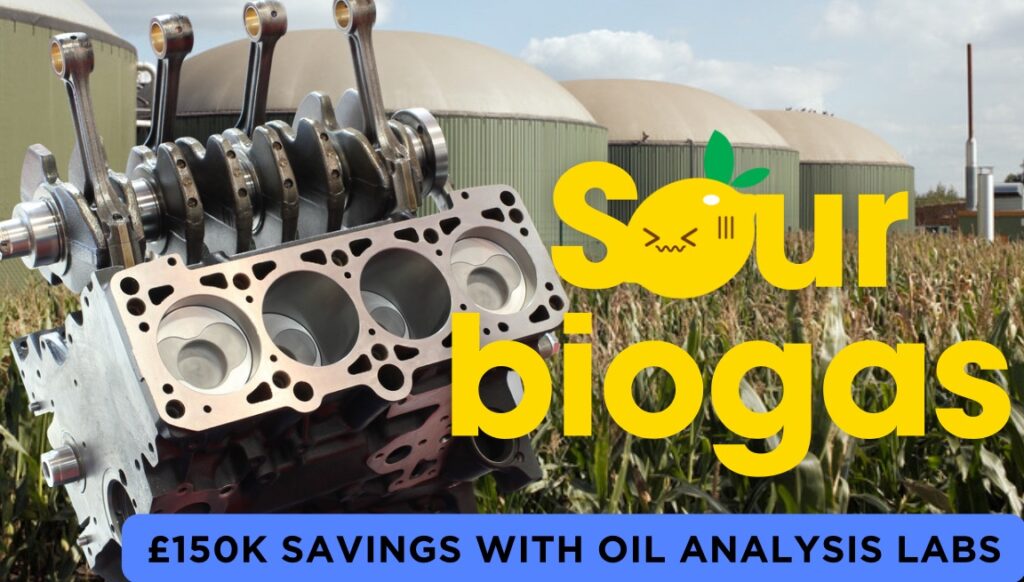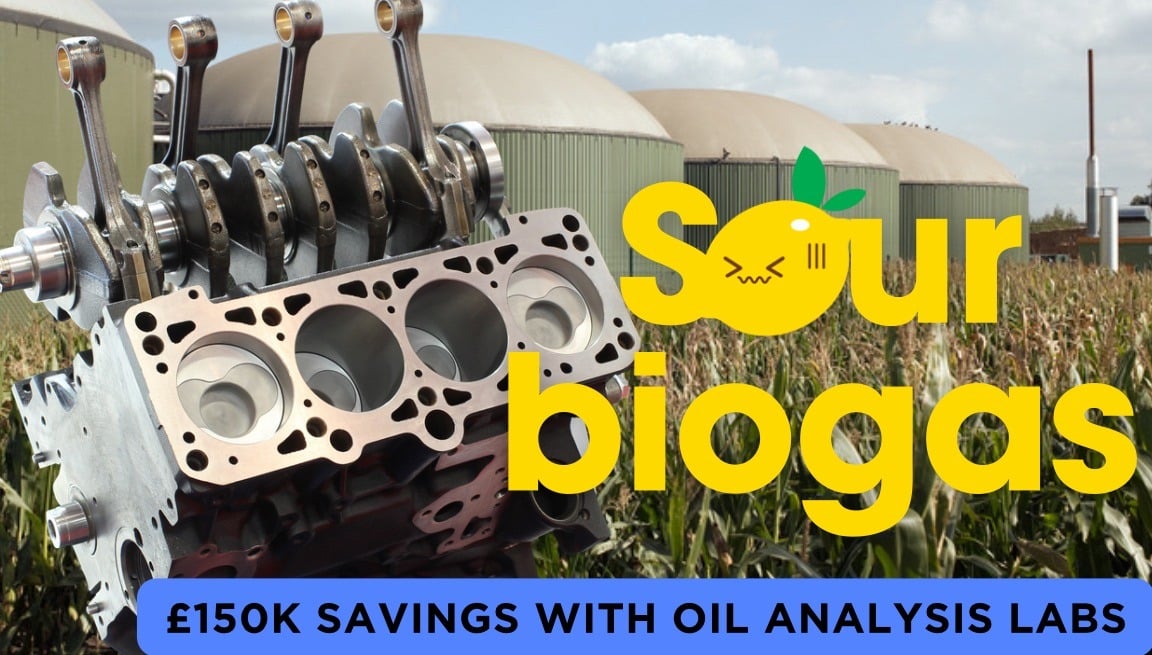
This case study examines how a medium sized biogas plant used advanced oil analysis to enhance maintenance strategies, reduce costs, and improve productivity. Biogas plants, which convert agricultural waste into energy, are vital for sustainable energy production. The plant faced frequent maintenance issues with its gas engines, leading to unplanned downtime and financial strain.
Background
The plant processes 30,000 tonnes of agricultural waste annually to produce biogas, which is then converted into electricity.
Challenges:
- Sour gas with high H2S content; which produces sulphuric acid in use. *see explainer on what is sour gas below.
- Frequent Engine Failures: Unexpected oil degradation led to frequent engine breakdowns, causing unplanned downtime.
- High Maintenance Costs: The cost of routine and emergency maintenance, including oil changes, was escalating.
- Limited Predictive Capabilities: Traditional time-based oil change schedules were inefficient and did not accurately reflect the oil’s condition.
Solution:
The biogas plant partnered with Oil Analysis Laboratories to implement the LubeWear method, a rapid acid digestion technique for oil analysis. This approach provided huge insights into the oil’s condition, enabling a shift from time-based to condition-based maintenance. Not only could high sulphation be identified but early signs of abnormal wear too.
Implementation:
- Data Collection: Regular oil samples were collected from the gas engines and analysed using the LubeWear technique to identify wearing components.
- Detailed Analysis: The analysis provided precise information about wear particles, contamination levels, and oil degradation.
- Condition-Based Maintenance: Maintenance schedules were adjusted based on the oil’s condition rather than predefined intervals.
Results:
- Extended Oil Change Intervals: Oil change intervals had been reduced to every 100 hours to protect for very sour gas spikes but were able to make it to 400 hours based on condition.
- Cost Savings: The plant saved approximately £150k annually in maintenance costs due to fewer oil changes and reduced downtime.
- Reduced Downtime: Unplanned downtime was reduced by 43% based on engine telemetry data, ensuring more consistent energy production.
Unexpected Benefits:
- Environmental Impact: The reduction in oil changes and waste contributed to the plant’s sustainability goals.
- Increased Lifespan of Equipment: The improved maintenance strategy extended the lifespan of the gas engines and other critical components.
By adopting advanced oil analysis techniques, the biogas plant improved operational efficiency, achieved significant cost savings, and enhanced sustainability. This case study highlights the importance of innovative maintenance strategies in the renewable energy sector.
For biogas plants and other energy producers facing similar challenges, investing in advanced oil analysis methods like the LubeWear technique can lead to substantial improvements in efficiency and cost-effectiveness. Contact Oil Analysis Laboratories to learn how you can implement these solutions in your operations.
Still Not convinced? For those who want a bit more detail on the case study please read on.
Explainer: What is Sour Gas?
Sour gas is natural gas that contains significant amounts of hydrogen sulfide (H₂S). Hydrogen sulfide is a toxic, corrosive, and flammable gas that gives sour gas its characteristic “rotten egg” smell. The presence of H₂S in natural gas can pose several challenges and hazards.
Characteristics of Sour Gas:
- Hydrogen Sulfide Content: Sour gas typically has an H₂S content greater than a few ppm (parts per million). Very high concentrations can be extremely dangerous and require stringent handling and processing protocols.
- Corrosive Nature: H₂S is highly corrosive, especially when combined with moisture, which can lead to severe damage to pipelines, storage tanks, and other infrastructure.
Processing Sour Gas:
Sour gas must be treated to remove hydrogen sulfide before it can be safely transported and used. This process, known as gas sweetening, typically involves:
- Absorption: Using amine solutions to absorb H₂S from the gas stream.
- Adsorption: Utilizing solid materials like activated carbon to capture H₂S.
- Oxidation: Converting H₂S into elemental sulfur or sulfate compounds.
By-Products:
The processing of sour gas often results in by-products such as sulfur, which can be commercially valuable but also pose environmental challenges if not managed properly.
Sour gas is a crucial energy resource that, when processed correctly, can be made safe for use. However, its handling requires careful consideration of the associated health, safety, and environmental risks.
How Sour Gas Comes from Organic Waste
Sour gas, which contains significant amounts of hydrogen sulfide (H₂S), can originate from the decomposition of organic waste, including animal manure and human waste. Here’s how the process works:
1. Anaerobic Digestion:
- Microbial Action: In environments devoid of oxygen (anaerobic conditions), microorganisms break down organic matter. This process occurs naturally in places like swamps, sewage treatment plants, and within biogas digesters.
- Stages of Digestion: Anaerobic digestion involves several stages—hydrolysis, acidogenesis, acetogenesis, and methanogenesis. During these stages, complex organic materials are broken down into simpler compounds, ultimately producing biogas.
2. Formation of Biogas:
- Methane and Carbon Dioxide: The primary components of biogas are methane (CH₄) and carbon dioxide (CO₂).
- Hydrogen Sulfide Production: Sulfur-reducing bacteria present in the waste convert sulfur-containing compounds (such as proteins) into hydrogen sulfide. This H₂S is what gives sour gas its characteristic rotten egg smell.
3. Sources of Organic Waste:
- Animal Manure: Farms with livestock produce large quantities of manure, which can be processed in biogas plants.
- Human Waste: Sewage treatment plants process human waste, capturing the resultant biogas.
- Food Waste: Organic food waste decomposes anaerobically, contributing to the production of biogas, including hydrogen sulfide.
Example Process in a Biogas Plant:
- Feedstock Input: Organic waste, including manure and sewage, is collected and fed into anaerobic digesters.
- Anaerobic Conditions: The digesters maintain an oxygen-free environment where microbes thrive and break down the waste.
- Biogas Collection: As the microbes decompose the waste, they release biogas, which is collected from the top of the digester.
- Gas Treatment: The collected biogas often contains hydrogen sulfide. To use this biogas safely, it undergoes treatment to remove H₂S, producing a “sweet” gas primarily composed of methane and carbon dioxide.
Environmental and Safety Considerations:
- Toxicity: Hydrogen sulfide is highly toxic, requiring careful handling and treatment.
- Corrosion: H₂S is corrosive to metals, necessitating the use of corrosion-resistant materials in biogas plants.
Summary:
Sour gas from organic waste is a by-product of the anaerobic digestion process. It involves the microbial breakdown of organic materials like manure and sewage, leading to the production of biogas rich in methane and hydrogen sulfide. Proper treatment and handling are crucial to mitigate the risks associated with H₂S.
So now you have had a great summary of sour gas the problem with this customer is the level of H2S was very high and led to initial pH in some engines of around 2 in places as the H2S formed sulphuric acid. The customer had on site various clean up processes but still the samples whenever we tested them stank very strongly of sulphur and showed huge sulphation peaks by infrared. The customer did some trial and error tweaks to the cleanup each week to find what worked. We helped them monitor this in the analysis with close initial pH, TAN and sulphation monitoring. Eventually they found a combination that got the oil to the point it could be extended safely beyond 100 hours based on condition whilst still doing weekly monitoring of the oil in case of sudden H2S spikes.
How did we calculate the savings?
The customer spent £147k less in 2 years using us than in the previous 2 years on oil, repair call out and parts.
They showed fewer failures and the raw data from engine management system showed increased utilisation. This figure was not added into the calculation but would make the customer additional revenue from electricity generation too.
Want more info how we can save you money then get in touch using the blue contact us button below.
